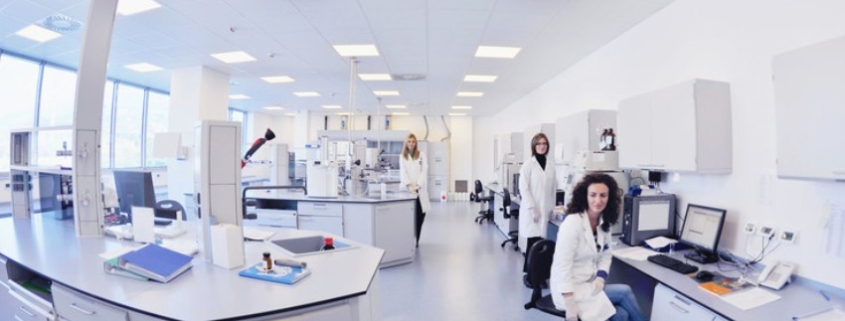Healthcare Design is an ever-evolving topic as systems must continuously adapt to meet complex regulations, reduce operating expenses, integrate emerging technologies, keep up with the quickly changing, consumer-driven landscape, and deliver world-class care to their communities.
E4H Environments for Health Architecture, partners closely with health systems to develop an approach to these diverse challenges. The following is a list of national design trends that the firm developed that will impact the healthcare design industry in 2019.
Designing for Resiliency
Healthcare facilities function 24/7 which requires them to be sustainably designed in order to maximize resources and reduce energy use/costs. With global warming’s effects quickly shifting the dynamics of our geography, the need for resiliency has made its way to the forefront of design discussions. How will the physical facility perform in the face of a natural or man-made disaster? What is the role of a hospital building to provide shelter and care to a community ravaged by a hurricane, flooding or wildfires? Can our buildings continue to function when all the municipal systems (water, power, sanitary services) around them are compromised? What protects the safety of patients and staff when there’s an active shooter on the premises?
These questions help us think beyond the standard disaster-preparedness drills to ensure the designs we develop thoughtfully address the needs of patients, staff, and their community in a time of unprecedented stress. New operational protocols require new plans, different physical barriers, and an innovative approach to the use of materials. Many E4H projects have been impacted by natural disasters such as Hurricane Sandy, this year’s Hurricane Michael in Florida, and the 7.0 Magnitude Earthquake in Alaska.
The Expanding Role of Genomics in Healthcare
Genomic research is impacting many fields of medical research and is emerging as a key disruptor in healthcare delivery and patient treatment. With rapid technological advances and decreasing costs associated with DNA sequencing, a more accessible diagnostic tool, genomic research has provided a new lens into difficult-to-diagnose and rare diseases
Additionally, Polymerase Chain Reaction (PCR), a mature molecular technology, is being refined through improved techniques, new assays, and much higher throughput capabilities than ever before. We are seeing more molecular testing being done in the clinical lab, with many hospitals creating entirely new Molecular Pathology departments. This genomic data is opening the doors to greater predictability of drug efficacy, an increase in personalized medicine and targeted therapies, resulting in improved patient outcomes. E4H clients such as the Dana Farber Cancer Institute are at the frontier of translational medicine in healthcare.
AI and Virtual Healthcare
Healthcare delivery has spent the last decades working to transform a process that is heavily dependent on data, and make it work smarter. Hospitals and health systems have been working hard to convert and optimize their databases to improve patient care and streamline processes. Artificial Intelligence is now poised to become the next evolution of healthcare data management, analysis and prediction.
The ability of AI to analyze data and predict outcomes and trends will have impacts not only in the clinical fields, but also operational and the physical environments. AI has already begun to demonstrate its ability to assist clinicians with diagnosis and prevention of medical errors. As this technology matures, it will have a profound impact both on care delivered at healthcare sites and in the virtual realm allowing for more informed diagnosis, smarter monitoring and alerts, and outcome predictions based on patient specific data. As facilities incorporate AI into their operations, it will allow them to look at the effect of the environment on patient, staff, and materials movements. Which will provide them with the opportunity to refine their operations through scheduling to enhance throughput and eliminate waste. This insight will help better inform changes to the physical environment to better suit their needs based on the data that they are able to extract about the flow of material and people within their walls.
AI will provide facilities with the ability to better predict their needs for supplies and deliveries such as medical supplies, food, linens, pharmaceuticals and energy based on patient scheduling. This will help facilities further reduce the costly footprint of onsite storage through better managed just-in-time deliveries.
Due to the growing need for patient data and medical records to be shared across a network of healthcare entities, blockchain integrations systems have seen a push in digital health as well. Blockchain has the potential to revolutionize healthcare by allowing the sharing and analysis of critical patient data in real time to improve quality of care. Blockchain also increases the ease of information sharing between healthcare providers and patient, thus making data much more secure which allows facilities to better manage their inter administration and IT workflows. It is vital for healthcare systems to become aware of the increased efficiency new technologies can quickly implement, for not only healthcare providers but for all end users alike.
Post-Surgery Accommodations
Health systems are constantly looking for ways to decrease operating expenses. One popular method is to alleviate the real estate footprint. This can be accomplished by moving administrative staff and outpatient services to off campus locations. A newer, growing trend is to move recovering patients off site to a nearby location where transportation is provided to and from the hospital if need be. This model is a convenient option for the patient, caregiver and provider. This allows for the patient and their family to have a sense of privacy, improving the patient experience as well as the rate of recovery.
Memorial Sloan Kettering’s 75th Street Patient Residence accommodates patients with blood cancers and disorders as well as patients receiving a bone marrow transplant. The residence offers fully furnished apartments with on-site concierge services to assist with care coordination. Transportation to and from Memorial Hospital is available.
Wellness Integration
With the healthcare industry shifting its focus to preventative, population health, wellness has gained significant momentum over the last several years. Wellness incorporates the entire body and all systems as why functional medicine is the science of health, focused on the person and restoring the body’s natural metabolic processes; where traditional medicine is focused on disease. Wellness is an integral part of delivering holistic healthcare.
As reimbursement continues to shift to a model that encourages preventative healthcare, we are seeing a shift in not only delivery of care but the physical aspects of the hospitals themselves. This growing trend can be seen in healthcare facilities across the country in the form of community gyms, yoga studios, and dietary kitchens fully loaded with cooking classes. This allows the health systems to make use of unused space, keep patients engaged and accountable for their healthcare by providing other interactions besides checkups and/or emergency situations. This shift provides an opportunity for the hospital to build relationships with the community. Many E4H clients offer nutritional services, full gyms, and community programs to promote wellness such as Covenant Health Lifestyle Centre in Lubbock,TX.
Boutique Medical Centers
There are two primary factors driving the rise of boutique specialty care centers, or precision medicine, nation-wide. One, a new and unique generation of informed healthcare consumers who expect quality, convenience and customization for all their needs, the other an advancing platform of technologies permitting providers a greater range of services bundled at a single point of care.
Millennials prioritize the enrichment of their health, lifestyles and experiences. Their decisions are based off quick and convenient platforms such as Google reviews, Yelp, Zocdoc, and several others that allow consumers to select a facility based off reviews vs a physician referral. Millennials are quick to express unmet expectations which has caused the healthcare systems to expand their service offerings. This new generation responds more readily to a successfully branded, boutique environments of clinical care.
Convenience is a pillar of retail success which suggests that healthcare systems will have to pivot in order to thrive in this arena. Healthcare providers are trying to diversify, differentiate and deliver their product distinctly to stay competitive. Fortunately, advances in technology and flexible design, have afforded clinical providers the means to offer broader ranged and more complex services in a single exam or treatment room; services that may have previously necessitated multiple visits to multiple locations. E4H projects such as the Hospital for Special Surgery Orthopedic Center Of Excellence in Palm Beach, FL offer full diagnostics services, ambulatory surgery, rehabilitation, and sports performance programs in one location.
Source: PRWeb




